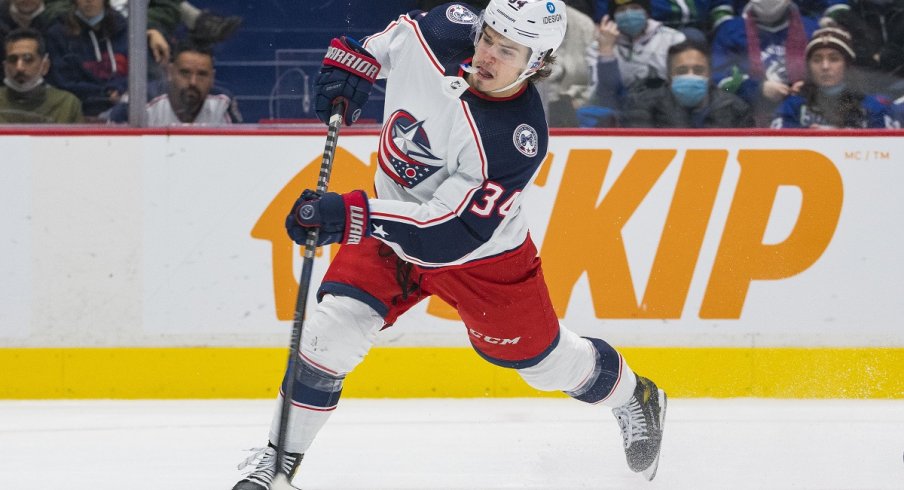On Wednesday, The Athletic's Corey Pronman released his 160-player ranking of top under-23 players and prospects.
To quote Pronman, "this analysis is forward-looking, meaning these are the players I would want on my team for the rest of their career, not in a game tomorrow."
The Blue Jackets had eight players on the list, which is a positive development. The average NHL team, based on a 160-player ranking, would expect to have five. That they have three in surplus at least helps to explain their current position in the standings, and their philosophy moving forward. On the other hand, none of the eight Blue Jackets prospects/players listed were in his top four (of his six total) tiers. In other words, in his estimation, there is no single U23 player in the organization that is a "projected top of the lineup player".
Obviously, that is one man's opinion, and I'd go on the record in saying that I strongly disagree with quite a bit of his rankings and analysis. But it is worth noting that it's an unbiased perspective from a person whose singular job is to know the universe of NHL prospects. With that, here are Pronman's ranking of Blue Jackets prospects and their relation to the rest of the NHL:
- 43 - Kent Johnson
- 44 - Cole Sillinger
- 56 - Kirill Marchenko
- 61 - Adam Boqvist
- 82 - Dmitri Voronkov
- 84 - Corson Ceulemans
- 127 - Alexandre Texier
- 138 - Liam Foudy
First of all, releasing a list like this is all but asking for controversy. It's incredibly difficult to distill prospects and players into the same list, because they're in different leagues, playing different roles, against different competitions, with different objectives. Nobody expects, say, Dmitri Voronkov, to be a top-line center. But is he an NHL player? Likely, yes. Is his peak 40+ spots higher than, say, Alexandre Texier? I would think not.
Then there are the omissions. Having Liam Foudy ranked but not Yegor Chinakhov is enough to make one question the legitimacy of the entire practice. But again, this could come down to the age-old 'floor vs. ceiling' debate.
Lastly, there's the 'now vs. later' argument. Pronman has Montreal's Nick Suzuki ranked #25 and in his fourth tier, whereas Buffalo's Rasmus Dahlin is ranked #7 and in the second tier. I would take Suzuki over Dahlin seven days a week and twice on Sundays, but understand that Pronman is essentially trying to articulate that (he believes) Suzuki is a finished product and Dahlin is not.
But in the interest of time, I won't focus on all of the spots in which I disagree with the rankings or the practice at large, but instead on what it means for the Blue Jackets, now and going forward.
Columbus is fortunate in that they should add two players to this list in the coming months by way of the NHL Draft. That Kent Johnson and Cole Sillinger are 43 and 44 among all U23 players in their D+1 year is of significance. Between their own and Chicago's pick, the Blue Jackets can expect to add to this pool. That is to say nothing of any potential trades, that could (though I wouldn't bet on it) return the draft capital to add a high-level prospect.
But while volume is good, elite skill is better. The top players in the Metropolitan Division for the past decade-plus have been top-five picks (Sidney Crosby, Alexander Ovechkin, etc.), and that trend appears to be continuing. Pronman's top two skaters, for example, are Andrei Svechnikov and Jack Hughes, who are both in the division and were both taken at or near the top of their respective draft.
In other words, it may be preferable today to be the New Jersey Devils, who also have eight players on the list, but the top players (Hughes) are #2 and the worst (Shakir Mukhamadullin) is #92, even if they seem to be around the same talent level as the Blue Jackets, as the current standings suggest.
Other teams in the Metropolitan are also fascinating case studies. Teams that have been competitive in recent years are less likely to have a lot of players on this list. Pittsburgh, for example, has one. The New York Islanders have three, and Washington and Philadelphia (if you consider the Flyers competitive in recent years) have four. But Carolina has six, including the top player in this list, and the New York Rangers have nine. Both of those teams sure look built for the present and future alike.
What does it all mean? Well, even if you consider the rankings to be flawed, it appears that having more players on this list is still clearly preferable than not. The Blue Jackets are well-situated, with eight young players that should represent a good chunk of the future of the team. But there's clearly room for further upside, either by way of internal growth or through additions by way of the draft.
